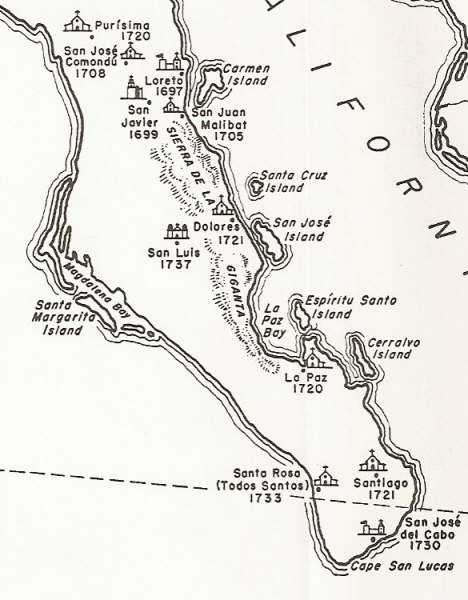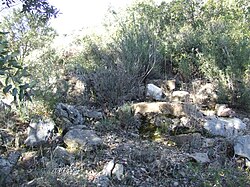I've been posting
about the California Missions in Alta
or Upper California and have bypassed the original ones established
in Baja, or Lower
California.
The
first mission established in The Californias [note the plural] was
the Misión
Nuestra Senora de Loreto Conchó, founded on October 19, 1697 by the
Jesuit priest Juan María de Salvatierra – a good seventy years
before Father Serra came on the scene. The town of Loreto went on to
become the religious and administrative capital of The Californias.
When
we think of “Governor” Portola, we often miss the point that he
was actually the Lieutenant Governor for Alta California. The
“governor” was actually Matias
de Armona who presided at Loreto – with no direct authority over
Portola, or Fages who followed.
Armona was openly hostile to the Franciscans, feeling the Jesuits who
were ousted, had been unfairly treated. This bitterness caused him to
be removed in 1775.
Those
who have visited Baja know it to be an arid, hostile land where every
plant reaches out to snag, grab, or sting you. What few animals that
live there are nocturnal. Those you might see during the day will
poison you with their venom. At the same time, the oceans surrounding
it contain some truly amazing and beautiful creatures. Sharks as big
as whales – without teeth! Giant Oceanic Manta Rays as big as some
light airplanes that fly awesomely through the Sea of Cortez.
Swordfish. Tuna. And massive gatherings of Hammerhead Sharks.
The
mission at Loreto was the basis for the other missions in both upper
and lower California and was based upon similar missions founded by
the Jesuits wherever they served. The other orders, Franciscan,
Dominicans, and Capuchins followed their model.
It
should also be remember that, at the time of the founding of the
missions in Baja, the weather was far different than in the 1800s and
today. The world was in the midst of The Mini Ice Age, a time when
lakes and rivers in Europe and North America froze solid for lengthy
periods and winters were especially long and cold. Sub-tropical areas
such as the American southwest, northern Mexico, and The Californias
were cooler with more abundant water. So, the missions were able to
sustain themselves then, while many have been abandoned.
These
were the natives who lived in Baja. Their lives were even more
primitive than other tribes to the north and east of them. They had
not progressed beyond the Stone Age and lived strictly by what nature
provided. They proliferated in times of plenty and died away in times
of drought – just like the plants and animals they lived with.
El
Camino
Real Misionero
The
road connecting the missions in Upper California was called El
Camino Real,
The King's Highway, while the one in Lower California was called The
Royal Missionary Highway/Path, whichever is most commonly used. It
was just that, a narrow pathway for the Jesuits to move from mission
to mission, often riding mules or donkeys. It was never designed for
wheeled vehicles and often crossed extremely rugged terrain.
After
founding the mission at Loreto, the Jesuits went on to establish
seventeen more, plus two ranchos and/or visitas [visiting stations or
country chapels which a priest might show up irregularly].
Without
a topographic map, it is extremely difficult to relate to just how
rugged and difficult the terrain and how the priests managed to make
their way from one to another.
This
is only the southern part of Baja and it is easy to see how separated
these missions are/were – some no longer stand.
I
think all of us are familiar with Cabo San Lucas and become confused
to learn the airport is actually in San José
del Cabo, or where the mission is actually located. And, the name of
the mission founded at the Pericú settlement of Añuití in 1730 by
Jesuit Father Nicolá Tamaral, is a real mouthful - Misión Estero
de las Palmas de San José del Cabo Añuití. A presidio, or military
base, was also located there.
The
most serious rebellion in the southern part of the Baja Peninsula
took place in 1734-1737. This uprising of the Pericú and Guaycuras
engulfed several missions in the southern part of the peninsula, most
of which had to be abandoned. In January 1735, indigenous forces
ambushed the Manila Galleon that had stopped at San José del Cabo
for supplies. "The revolt and its subsequent suppression,"
according to Don Laylander, "hastened the disorganization and
declines of the southern aboriginal groups. To suppress the revolt,
the Jesuits were forced to call in outside military assistance."
In 1742, King Felipe V authorized the use of royal funds to suppress
the revolt. The arrival of a military force from Sinaloa helped to
restore order and reestablish control of the southern Baja lands. The
last scattered resistance to the Spaniards did not end until 1744.
Misión San José del Cabo was re-established in 1736 as a visita of
Mission Santiago, and finally closed in 1840 by the Mexicans.
In
1990, I loaded my wife and her five kids into my 1964 Dodge 400
station wagon. We took the car ferry from Mazatlan to La Paz. We were
in a hurry to get to Tijuana so we only drove past la Misión de
Nuestra Señora del Pilar de La Paz Airapí, established by the the
Jesuit missionaries Juan de Ugarte and Jaime Bravo in 1720. It was
also involved in the Pericú and Guaycura revolt. All of its Indian
neophytes and disciples were relocated to Misión Santa Rosa de las
Palmas in Todos Santo.

Franciscans
establish their only mission
[The only pictures are of some adobe brick piles]
In
1769, on orders of Visitador Galvez, Father Serra led an expedition
north to establish Misión San Fernando Rey de España de Velicatá,
the only Franciscan mission in Baja. In the 1770s, under the
Franciscans and then after 1773 under their Dominican successors, the
mission quickly reached its peak and went into decline as epidemics
decimated the native population. A missionary was no longer
permanently resident at the site after about 1818. A few ruined walls
and stone foundations survive at the site as well as petroglyphs and
some remains of pictograms.
Representatives
of the Dominican order arrived in 1772
To
Loreto came more and more fathers from many countries of Europe, as
the work
expanded
west over the steep ridges of La Giganta. The usual procedure in
founding a
mission
was to find a suitable site with water and pasturage. Trails had to
be hacked out
for
mule trains bringing supplies from the mother mission. Then Indians
were gathered
and
with their help buildings erected and crops sown. Ingenious systems
of irrigation
were
devised. But on Baja California there was always a struggle with the
elements.
Drought
caused springs to dry up and crops to wither; because of it many a
mission had to move its site. Torrential rains brought floods to wash
away the hard-won fields; winds of hurricane force knocked down the
first crude buildings. If the weather proved kind, along came swarms
of locusts to strip the green leaves from every growing thing. After
years of struggle, however, the fathers could point proudly to
orchards, patches of vegetables and melons, date palms - some of
which still survive - fields of grain, sugar-cane and cotton, flocks
of cattle, sheep, horses and mules. Over the rough trails the fathers
went forth to found new missions north and south.
The
Dominican mission closest to the Mexican/Californian border is Misión
El Descanso or Misión San Miguel la Nueva founded in 1817 at a site
about 22 kilometers south of present-day Rosarito. It was the last
founded by the Dominicans and the furthest north.
This
is an artist's depictions of what the mission garden once looked
like.
Sadly,
wind, weather and political considerations have laid waste of many of
those missions in the arid deserts of Baja. Those in the best
condition are still places of worship for the heavily Roman Catholic
population. Here are some pictures of those currently in service as
churches:
Misión
de Nuestra Señora de Guadalupe del Norte
Misión
San Francisco Borja
Misión
Santa Gertrudis
Misión
San Ignacio Kadakaamán
Misión
Santa Rosalía de Mulegé
Misión
San Francisco Javier de Viggé-Biaundó
Misión
San Luis Gonzaga Chiriyaqui
If
you really want a taste of history, these are well worthwhile
visiting.





